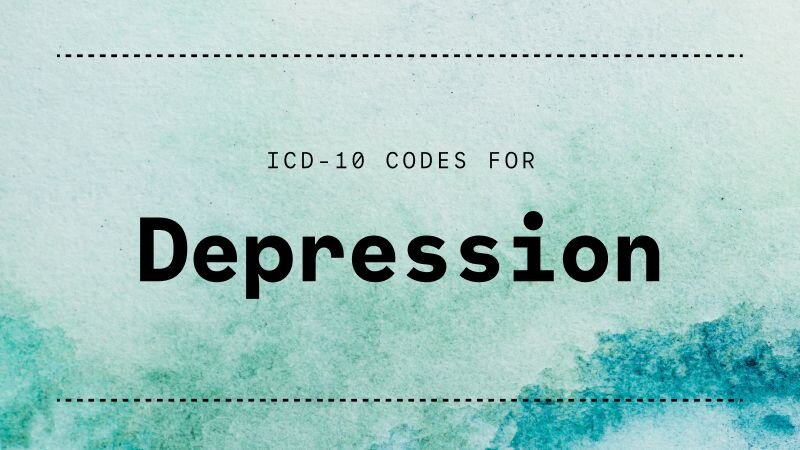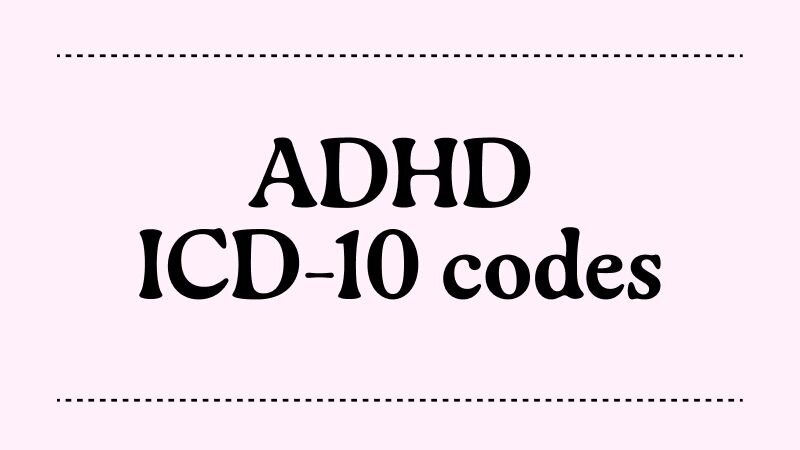
ICD-10 codes for depression
Here are some of the most common ICD-10 codes associated with depressive symptoms, with different criteria for frequency, severity, and other features.

A client presenting the symptoms of ADHD will most commonly be diagnosed with a specifier code that provides detail about how their symptoms present.
Diagnosis codes for attention-deficit hyperactivity disorder, or ADHD, are included in the ICD-10 under the section “Behavioral and emotional disorders with onset usually occurring in childhood and adolescence.”
Although it’s associated with adolescence taxonomically, many adults also experience symptoms of ADHD: It’s a disorder that begins in childhood but can be diagnosed at any age.
ADHD diagnosis requires formal testing from a licensed and trained professional.
It’s important that you make a clear, accurate and specific diagnosis that is appropriate to your individual patient clinical picture. These examples should be for reference and are not intended to guide a diagnosis. The client must meet diagnostic criteria for the F code they are assigned.
A client presenting the symptoms of ADHD will most commonly be diagnosed with one of the following specifier codes, based on if their symptoms present as inattentive, hyperactive, both, or neither.
The most common diagnosis is combined type ADHD, where the client displays symptoms of both inattentive type and hyperactive type.
The diagnosis of symptoms for each subtype is based on the criteria description for F90: Hyperkinetic disorders:
A group of disorders characterized by an early onset (usually in the first five years of life), lack of persistence in activities that require cognitive involvement, and a tendency to move from one activity to another without completing any one, together with disorganized, ill-regulated, and excessive activity. Several other abnormalities may be associated. Hyperkinetic children are often reckless and impulsive, prone to accidents, and find themselves in disciplinary trouble because of unthinking breaches of rules rather than deliberate defiance. Their relationships with adults are often socially disinhibited, with a lack of normal caution and reserve. They are unpopular with other children and may become isolated. Impairment of cognitive functions is common, and specific delays in motor and language development are disproportionately frequent. Secondary complications include dissocial behavior and low self-esteem.
The World Health Organization’s official ICD-10 manual is available online, where you can find a list of diagnosis codes associated with ADHD symptoms, listed under F90–F98: “Behavioural and emotional disorders with onset usually occurring in childhood and adolescence."
The ICD-10 Database is another source for detailed clinical information about each ICD-10 code. This database is maintained by AAPC, the American Academy of Professional Coders.
Not all ICD-10 codes are accepted for insurance billing. Each insurance company typically has its own specific guidelines for claim submission, and have lists of covered and non-covered codes, so it’s important that you stay up to date with the billing requirements of the insurance plans you’re credentialed with to ensure the codes you’re using are supported for reimbursement.
The ICD-10 is a coding system developed by the World Health Organization (WHO) for the classification of diseases and other health-related conditions. The alphanumeric codes in the ICD-10 are used by healthcare providers and insurance companies to represent disorders and other health conditions for the purpose of standardizing medical records and billing.
Its name, ICD-10, stands for the International Classification of Diseases 10th Edition; the 10th edition was endorsed in 1990 to replace the ICD-9, and fully adopted in the United States by October 1, 2015.
The DSM-5 (Diagnostic and Statistical Manual of Mental Disorders, Fifth Edition) and the ICD (International Classification of Diseases, Tenth Revision) are both classification systems used in the diagnosis of mental health disorders, but they have different origins, purposes, and scopes.
The DSM-5 is published by the American Psychiatric Association (APA), is used primarily in the United States, and focuses exclusively on mental disorders.
The ICD-10 is published by the World Health Organization (WHO), is used worldwide, and covers all health-related issues, not just mental disorders.
The DSM-5 is compatible with the ICD-10 coding system now in use by many insurance companies. Because it has a narrower scope, the DSM-5 includes more detail about the diagnostic criteria for mental disorders. The criteria included in the DSM-5 can be used to diagnose mental health disorders, and documentation should demonstrate the support of this diagnostic criteria.
This document is intended for educational purposes only. It is designed to facilitate compliance with payer requirements and applicable law, but please note that the applicable laws and requirements vary from payer to payer and state to state. Please check with your legal counsel or state licensing board for specific requirements.

Here are some of the most common ICD-10 codes associated with depressive symptoms, with different criteria for frequency, severity, and other features.

There are many ICD-10 codes associated with anxiety disorders. Generalized Anxiety Disorder is most common, but there may be a more precise code that documents your diagnosis more effectively.

The ICD-10 includes one general code for PTSD, along with specifier codes that include a greater level of detail.